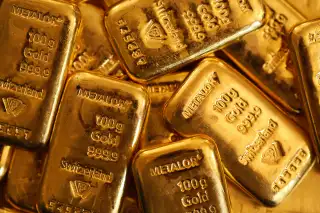Gold is Crashing! No, Wait, it's Booming! So What's Really Going on With Gold?

Gold is a little strange as far as commodities go.
You don't run your car on gold. It doesn't heat your home, and you can't eat it. It doesn't generate profits or pay dividends. Nevertheless, whenever investors feel skittish about a particular aspect of the global economy, demand for the stuff increases.
Consider recent events in China. The government in Beijing let its currency, the yuan, devalue against the dollar in a bid to make exports more competitive, thereby adding economic growth to the suddenly struggling world power. This uncertainty has been credited in the financial press for supporting the price of gold, which jumped 3% from $1,087 an ounce on Aug. 3 to $1,116 yesterday.
Despite this recent jump, gold is in a four-year decline after breaching $1,900 an ounce in August 2011 as the U.S. economy has slowly convalesced. So how should you think about the price of gold? And should you own the material in your portfolio?
Investor psychology
Gold is a volatile commodity that rises and falls in the short and intermediate term depending on the animal spirits of the economy. Take SPDR Gold Shares, an exchange-traded fund that actually owns and stores bullion in a London vault. Over the past year the once second-largest ETF in the world has declined about 1% as the domestic economy keeps adding jobs at a nice clip.
"There's been a lack of interest among U.S. investors in gold because it hasn't done anything for you," says portfolio manager for USAA Precious Metals and Minerals fund Dan Denbow. "It's done nothing for investors over the last three years. They would have been better off in Google and Facebook."
With the S&P 500 up 10% over the past 12 months, there's less appetite for the metal.
And when Chinese officials signaled support for the yuan after devaluing, the surge in gold demand quickly receded.
The value of the dollar
The strong U.S. dollar provides a roadblock for gold investors.
Despite moves by the Federal Reserve to purchase trillions of dollars worth of bonds and keep short-term interest rates at basically 0% since the Great Recession, the U.S. dollar has shot up. (Which isn't as good for American companies as you may think.)
Either way, the greenback has strengthened considerably against most major currencies over the past year—including almost 8% against the euro—and the dollar index has jumped 7% since the beginning of the year.
With signs pointing to a short-term interest rate increase by the Fed sometime later this year or in early 2016, it's hard to see U.S. investors pining for gold in the near term.
Dan Denbow is quick to point out, however, that gold has been a good investment for some investors, like those in Canada, since their currency has weakened generally. While American investors using dollars would have seen a 9% decline so far this year investing in gold, Canadian bullion holders have enjoyed a 10% increase.
Forget about inflation
Conventional wisdom holds that gold is used as a hedge against rising prices. And that's true, in the very long run. "In 562 B.C., during the reign of the Babylonian King Nebuchadnezzar, an ounce of gold bought 350 loaves of bread. At today's gold price, that's $3.14 per loaf - roughly what I pay at Whole Foods," says Duke University finance professor Campbell Harvey, co-author of the recent paper "Golden Constant."
But you're not going to live that long, unfortunately. "Our investment horizons are much shorter," says Harvey. "As such, in these shorter horizons, gold cannot be counted on to provide an inflation hedge."
And over the next ten years, the price of gold could go down a lot, per Harvey and co-author Claude Erb, even while inflation stays muted. The pair calculated that the fair value of the yellow metal is $825 an ounce, but it could fall as low as $350 an ounce if the sell-off follows historical examples in the middle of the 1970s and later in the 1990s.
That's a loss of about 3% per year or "11% per year if the real price of gold overshoots and declines to previous low real price levels," says Erb and Harvey in their paper.
Golden satellite
What does this mean for your portfolio?
If you're going to include gold, don't take on very much of it. Even Denbow, a manager of gold fund, says bullion should never make up more than 10% of your holdings.
"We tell our investors that gold is for diversification, for that rainy day," says Denbow. "And so when everything's good in U.S. you're going to care less. But it's there for that exogenous event, that geopolitical activity that unsettles things."
When fear was in abundance in 2008, for instance, SPDR Gold Shares jumped 5% while the stock market fell 37% and commodity funds in general dropped 33%.
So it can make sense to appropriate a sliver of your portfolio to gold for some ballast. Don't be surprised though if prices continue to drop in the short term.